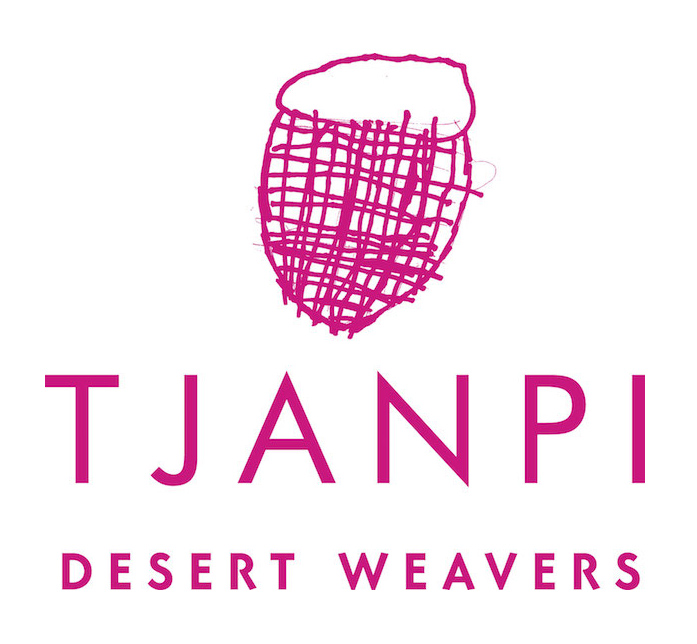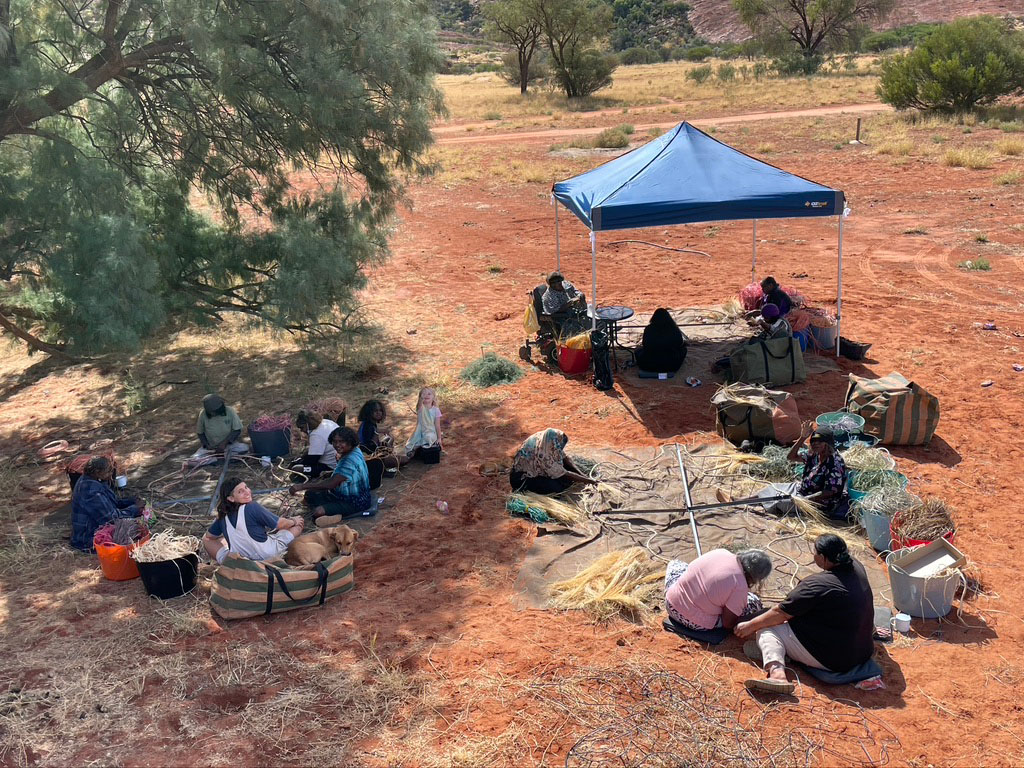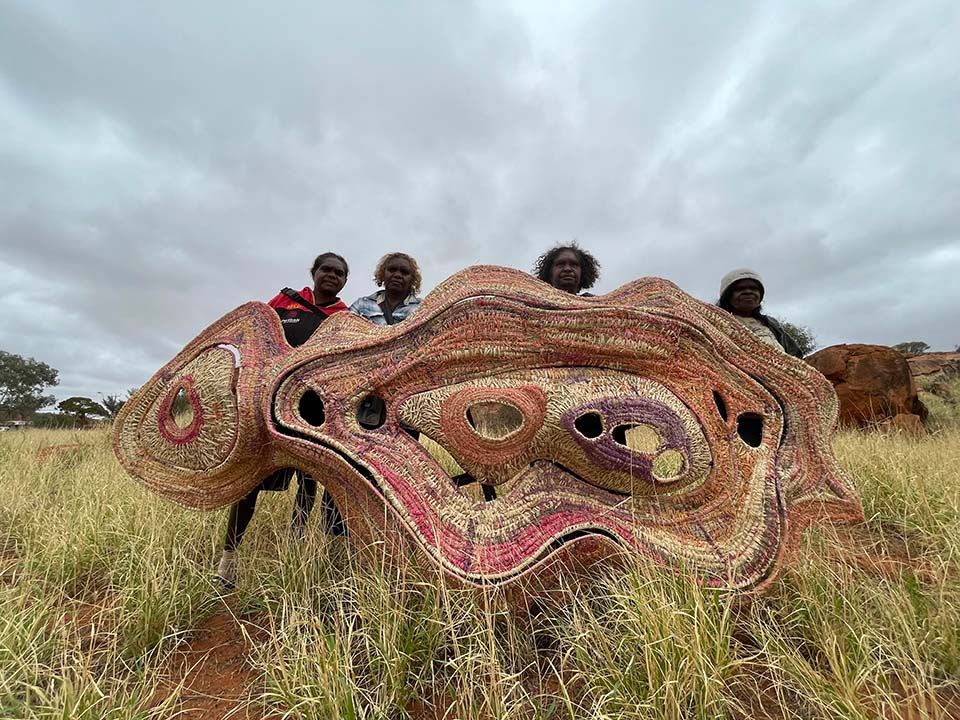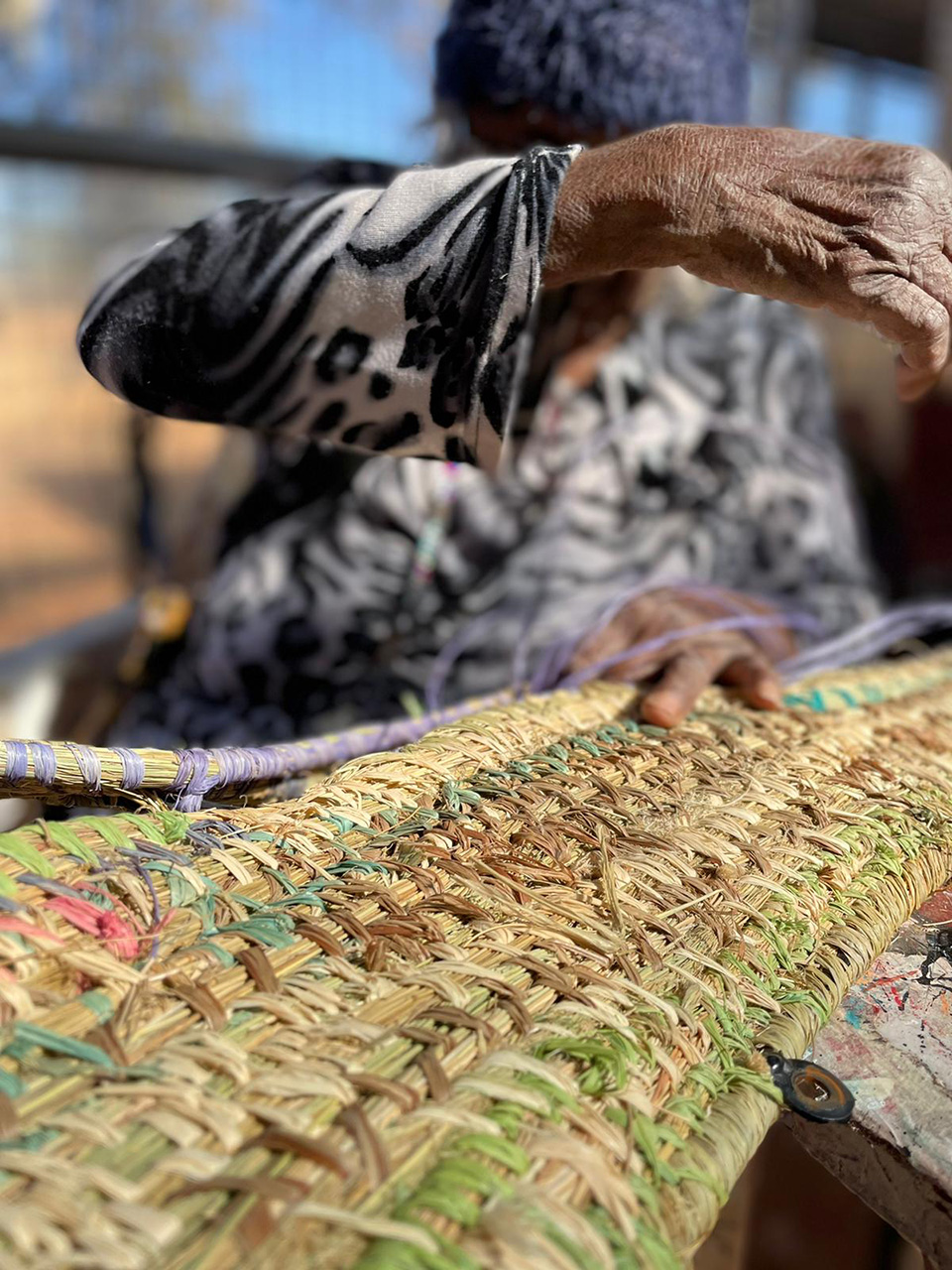Artist biographies
Allan Sumner
Allan Sumner produced the painting and rug on level 9. He also produced the designs for the meeting room decal for each floor at 83 Pirie Street.
Learn more about Allan Sumner (Ngarrindjeri)
Born in 1975, Allan is a descendent of the Ngarrindjeri people who come from the lower Murray and the lakes of the Murray River along the Coorong of South Australia. He is also descendent of the Kaurna people from the Adelaide plains region and the Yankunytjatjara people from central Australia.
In addition to being an established musician, Allan is also an accomplished visual artist and graphic designer. Through the love of his heritage, he facilitates cultural tours and is a popular provider of workshops in schools and community groups where he teaches Aboriginal arts and culture. He has also had extensive experience working in the health sector as an Aboriginal Health Professional.
Allan has taken a passionate interest in Dreaming Stories, spending valuable time with his Elders. Retracing ancient art forms, Allan communicates the stories, passed down from generation to generation, through his contemporary art pieces.
Over the past three years, his works have remarkably matured. Allan creates visually arresting landscape works employing earthy tones intertwined with cooler tones to represent rivers, lakes and the oceans that form patterns to provide a sense of movement.
Today Allan mostly paints with acrylic applied onto canvas, with various artworks having been exhibited in Tandanya National Aboriginal Cultural Institute. He also makes boomerangs, bark shields, didgeridoos, and other cultural artefacts that have been gifted to visiting dignitaries and international sporting teams.
Elizabeth Close
Elizabeth Close produced the Seven Sisters Songline Design which is the ceiling artwork on each floor, starting near the kitchen around the floor (pass the stationery room(s) and up to the most southern floor entrance).
Learn more about Elizabeth Close (Anangu)
Elizabeth Close is an Anangu woman from the Pitjantjatjara and Yankunytjatjara Language Groups, whose family links are to the communities of Pukutja and Amata in the APY Lands.
Elizabeth was born in Adelaide but grew up in outback SA, returning to Adelaide to complete her secondary schooling, and attend university to complete a Bachelor of Nursing.
In 2007, Elizabeth began to paint professionally and exhibit her work throughout Adelaide and her practice organically grew as she balanced nursing, art and motherhood. By 2014 she had built up a full-time arts practice, and after the birth of their second child, Elizabeth and her family relocated to the APY to reconnect with family, language, and culture; something that is profoundly reflected in the evolution of her work.
Currently, Elizabeth is a mid-career, Aboriginal Visual Artist living and working on Unceded Kaurna Country. She has spent the past 16 years crafting a dynamic and bold multi-disciplinary arts practice that speaks to the politics of Aboriginality, her own personal Connection to Country and the concept of connection to place and space more broadly; more specifically, how it relates to Aboriginal and Torres Strait Islander relationships with the landscape and ways of being and knowing.
She works primarily in the mediums of 2D arts, large scale public art and digital media, and thrives in experimentation and challenge.
Tjanpi Desert Weavers
The Tjanpi Desert Weavers produced four pieces of weaving artwork for the 83 Pirie Street office – on levels 5, 7, 11 & 13.
Learn more about The Tjanpi Desert Artists

Tjanpi Desert Weavers is a social enterprise of the Ngaanyatjarra Pitjantjatjara Yankunytjatjara (NPY) Women’s Council, working with women in the remote Central and Western desert regions who earn an income from contemporary fibre art. Tjanpi (meaning grass in Pitjantjatjara language) represents over 400 Anangu/Yarnangu women artists from 26 remote communities on the NPY lands.
The NPY lands cover approximately 350,000 square kilometres across the tri-state (WA, SA, NT) border region of Central Australia and Tjanpi field officers regularly traverse this area to visit each community. On these trips, field officers purchase artworks from artists, supply art materials, hold skills development workshops, and facilitate grass-collecting. While out collecting grass, women are also able to spend time on Country and maintain their culture through gathering food, hunting, performing inma (cultural song and dance), and teaching their children.
 Figure: Map showing the NPY Women's Council region.
Figure: Map showing the NPY Women's Council region.
Tjanpi (meaning ‘dry grass’) evolved from a series of basket weaving workshops held on remote communities in the Western Desert by the NPY Women’s Council in 1995. Building on traditions of using fibre for medicinal, ceremonial and daily purposes, women took easily to making coiled baskets.
Tjanpi artists use native grasses to make spectacular contemporary fibre art, weaving beautiful baskets and sculptures and displaying endless creativity and inventiveness. Originally developing from the traditional practice of making manguri rings, working with fibre in this way has become a fundamental part of Central and Western desert culture.

Tjanpi embodies the energies and rhythms of Country, culture, and community. The shared stories, skills and experiences of this wide-reaching network of mothers, daughters, aunties, sisters and grandmothers form the bloodline of the desert weaving phenomenon and have fuelled Tjanpi’s rich history of collaborative practice.
Tjanpi has a public gallery in Alice Springs showcasing baskets, sculptures, jewellery, books, merchandise and more, while Tjanpi artworks are also found at stockists around the country. Tjanpi regularly exhibits work in national galleries and facilitates commissions for public institutions.



Work by the Tjanpi Desert Artists has been acquired and exhibited widely by major public art institutions in this country including the Art Gallery of NSW, Art Gallery of SA and National Gallery of Australia.
The weaving pieces were produced by several Tjanpi Artists.
- Level 5’s piece Kapi Tjukurla (Rockholes) was produced by Julie Yangki, Amy Yangki, Margaret Yai Yai & Rita Rolley.
- Level 7’s piece ApuTjuta (All the rocks) was produced by Sheena Dodd, Kunmanara (Ngilan) Dodd, Kathy Dodd, Fiona Dodd, Rhonda Young & Rita Norman.
- Level 11’s piece ApuTjuta (All the rocks) was produced by Harriet Bryant, Pauline Wangin, Betty Mula & Eliza Wangin.
- Level 13’s piece Kapi Tjukurla (Rockholes) was produced by Maringka Burton, Nellie Coulthard, Betty Chimney, Daisy Barney, Sonia Bannington, Priscilla Singer, Raelene Wallatina, Ngila Mungkuri, Maxine Stewart & Betty Muffler.
Julie Yangki
Julie grew up in Mimili, South Australia.
She is a dedicated Tjanpi weaver, a strong cultural woman, and a superb traditional dancer. Julie makes distinctive, beautiful and highly sought after baskets featuring wangunu and minirri (native grasses), multi-coloured twined raffia and stitched emu feathers. Julie is a slow and steady weaver, taking her time to make well formed, strong baskets and sculptures.
Amy Yangki
Amy Yilpi is an artist belonging to the Pitjantjatjara language and cultural group and lives in the remote community of Mimili, South Australia.
Amy was born in Alice Springs, Northern Territory, but later returned to Mimili for schooling. She is the daughter of Julie Yangki, a dedicated Tjanpi weaver and a strong cultural woman in their home community. Amy continues to reside in Mimili with her husband Michael Butler and their three children.
As Amy’s husband is related to the Butler’s of Warakurna, Amy regularly travels there for extended periods of time. It was on one of these trip in 2018 that Amy began to learn to weave from her sister-in-law Ruth Bates. Very quickly, Amy became both an astute artist and business woman, producing a high volume of well-made, brightly-coloured animal sculptures. Prior to weaving, Amy has also been an accomplished painter and punu (wood) carver.
Pinuka (Margaret) Yai Yai
Pinuka Lives in Mimili Community and makes beautiful strong and thoughtful baskets.
Pinuka works with local grasses, coloured raffia and wool, weaving with great attention to detail and a refined technique. While she has only been weaving for a few years, Pinuka has already developed a distinct style based on her neat and considered weaving approach.
Rita Rolley
Rita Rolley is from Fregon on the Anangu Pitjantjatjara/Yankunytjatjara Lands in the far north-west of South Australia and brings to her artwork a strong connection with her traditional heritage.
Rita’s sense of place and independent personality shine through in her artworks which have a contemporary edge created through the use of colour and form while incorporating traditional cultural aspects.
Rita works across many artistic mediums including painting, prints, wood carving as well as Tjanpi weaving. Rita’s Tjanpi baskets and sculptures embody whimsy, humour and a unique creativity.
Sheena Dodd
Sheena Dodd lives at Mimili Community on the APY Lands. Sheena's mother is Margaret Ngilan Dodd and her father is Sammy Dodd.
Her mother's country is associated with Ted's Bore, near Sandy Bore, about 20 kilometres from the Mimili Community, and her father's country is near Kenmore. Sheena is married to Richard Neilson and has five sons and one daughter.
Sheena commenced making baskets for Tjanpi Desert Weavers in 2010, then following a workshop held at Mimili in mid-2011 commenced making sculptures. In a very short time she has become highly skilled as a fibre sculptor, creating works that reveal her exceptional eye for form, shape and colour.
Sheena delights in creating a range of animals that catch her eye, not only those with which she is familiar from around the community and out bush, but also animals from afar. She captures the essential qualities of the birds and animals she creates in a highly expressive and entertaining way.
Kunmanara (Ngilan) Dodd
Kunmanara (Ngilan) Dodd was a Pitjantjatjara/Yankunytjatjara woman born at Teeta Bore.
She transitioned from living nomadically in her first years to working at Everard Park Station as a young woman, before it was returned to Aṉangu traditional owners. Alongside her husband Sammy, she remained one of the most knowledgeable songkeepers for Mimili community until her passing in 2023.
Kathy Dodd
Kathy Dodd is an artist belonging to the Pitjantjatjara language and cultural group and lives in the remote community of Amata, South Australia.
Kathy was born at Imanpa near Mount Ebenezer in the Northern Territory. Kathy is married to Sandy Dodd, the son of Margaret and Sammy Dodd from Mimili. Both of Kathy's parents passed away when she was very young. Kathy has three children, two sons (one deceased) and a daughter.
Kathy began making baskets for Tjanpi in 2010, then following a workshop held at Mimili in mid-2011 commenced making sculptures. Her creative flair and skill as a sculptor soon became evident. Like so many of the Tjanpi weavers, Kathy has a wonderful eye for detail and is a keen observer of the natural world. Her expressive works reveal her great dexterity as a sculptor.
Fiona Dodd
Fiona is the daughter of Senior Artist Sheena Dodd, and has learned her craft from one of the best.
She has two little daughters herself and enjoys making baskets and animated faces on her animals. Fiona likes walking around on country, picking up the tjanpi grasses that grow not too far from Mimili community, sometimes she also goes and sits with her Aunty Margare Dodd who is an expert basket maker and generally lovely company for an afternoon of weaving.
Rhonda Young
Rhonda Young is an artist belonging to the Pitjantjatjara language and cultural group and lives in the remote community of Mimili, South Australia.
Rhonda picked up her weaving skills from watching her family members make baskets and sculptures throughout her life. Taking part in Tjanpi weaving workshops in the past, Rhonda was excited to participate in the making of several large-scale sculptural pieces that were commissioned by Guildhouse in 2022.
Rita Norman
Rita Norman is an artist belonging to the Pitjantjatjara language and cultural group and lives in the remote community of Docker River, Northern Territory. She is a young weaver who began making baskets with Tjanpi in 2021.
Harriet Bryant
Harriet Bryant is an artist belonging to the Pitjantjatjara language and cultural group.
Harriet was born in Amata, South Australia, but later moved to the neighbouring community of Mimili with her husband. Her father is from spinifex area, around Tjuntjuntjara. Together with her husband, they have three children.
Harriet first learned to make Tjanpi by watching her Aunty Julie Yangki and Pinuka Yai Yai at Julie’s home in Mimili back in 2014. She started just watched and then the ladies helped teach Harriet - she now enjoys creating whimsical animal forms such as donkeys and kangaroos.
Harriet is known by Tjanpi staff as a ‘workshop guardian angel’. She is a bizz of energy, always helping the workshops run smoothly, making tea for the ladies, helping translate Pitjantjatjara to English, and making sure things are in order. Harriet also works as an arts worker for Mimili Maku Arts, both painting and supporting other artists to paint at the local art centre.
Pauline Wangin
Pauline was born in Indulkana on the APY Lands in the far northwest of South Australia. She grew up in the neighbouring community of Mimili.
Pauline started working at the art centre when it was first founded. For many years, Pauline was a dedicated artworker until she started focusing entirely on her painting practice in recent years. Her paintings resonate with a deep appreciation for the landscape and the stories that have created it, featuring elaborate detail and meandering pathways reflecting the intricate network of waterways on country.
Betty Mula
Betty Mula was born in Mparntwe (Alice Springs) in 1973 and was brought up by her mother in Imanpa. After attending school in both Imanpa and Mparntwe, Betty starting painting at Imanpa Craft Room.
One of Betty's sisters lived in Mimili community at the time. When she passed away in the late 1980s, Betty came to Mimili community for Sorry Business. In Anangu culture, funeral rites can last for many weeks. While in Mimili Betty met her husband, Teddy Wangin.
Betty is a cheerful woman who spends most days in the art centre, but also has a wealth of knowledge for Country and its traditional foods. On the weekends, Betty can often be found out bush hunting for tinka (goannas) or maku (witchetty grubs).
Eliza Wangin
Eliza Wangin is a young woman belonging to the Pitjantjatjara language and cultural group and lives in the remote community of Mimili, South Australia.
She is the daughter of established Tjanpi weaver Pauline Wangin, who has gone on to shared these skills with Eliza. Having taken part in Tjanpi weaving workshops in the past, Eliza was eager to participate in the making of several large-scale sculptural pieces that were commissioned by Guildhouse in 2022.
Maringka Burton
Maringka was born near Wingellina and grew up in Ernabella community.
She went through school in Ernabella and spent most of her youth there. She later moved to Amata and then to Indulkana where she raised her family and still resides today.
Maringka is a mother and grandmother for lots of young kids. She is an artist of many mediums including Tjanpi weaving, painting canvas and beaded jewellery. Maringka is also a practising ngankari (traditional healer) and works with the NPY Women's Council to provide traditional healing services.
"I am a senior lady at Iwantja, and I began working as an artist at Iwantja Arts a long time ago, me and Kunmanara Singer were the first women artists here. I help look after the art centre and go to the big meetings for them. I also enjoy singing and I travelled to sing in the opening ceremony of the Sydney Olympic Games, I want to keep painting and doing inma (ceremonial song and dance) always. My father was a special ngangkari (traditional healer) and he taught me about healing; now I am ngangkari too. I do lots of work for the women’s council, I’m always helping at their big meetings and supporting Anangu women. As artists and as a community, we should always do more work with the young people, making things together and teaching them about the old ways too, always remembering country, this is a good way."
Nellie Coulthard
Nellie Coulthard was born in desert bush and near Oodnadatta, on the remote property of the Wintinna Homestead Cattle Station.
Her father worked as a shepherd for a local station, Nellie and her family travelled constantly and slept outdoors supporting her father and caring for the sheep. Nellie has two brothers and two sisters and has lived at the Indulkana community since she was a young lady.
Nellie has been making paintings at the Iwantja Art Centre for many years. Her work often speaks to memories and stories of the country she recalls as a young girl, they reference her childhood experiences of living in the country. An accomplished textile maker, Nellie’s structural pieces are created with extreme skill and finesse, she enjoys making unique baskets and abstract forms with tjanpi grasses and coloured wools.
Betty Chimney
Betty Chimney is a long-time artist and director of Iwantja Arts. A dedicated painter, Betty’s work is inspired by her ancestral Yankunytjatjara country and a determination to maintain her strong connection to country and culture.
In addition to her own painting practice, Betty works on large-scale collaborative paintings with her daughter Raylene Walatinna. Through the process of working together with her daughter on collaborative paintings, Betty continues the tradition of older women passing on their important knowledge of Tjukurpa (Anangu cultural stories) and Ngura (Country) to younger women.
Daisy Barney
Daisy Barney was born near Mount Chandler near the Indulkana community. When she was a young girl, her family moved to live at the Iwantja creek. Daisy and her family would often hunt and venture out for bush foods such as Maku (Witchetty Grub) and Tjala (Honey Ant).
Her mother would make Nula Nula (clapping Sticks) and Piti (bowl) to sell to the travellers on the highway. Daisy would assist by burning the decorations into the wood with wire.
Daisy has worked at Iwantja Arts alongside her daughters, Dianne and Kunmanara (Kerry Ann) Robinson. Throughout her practice she has worked with a range of mediums, including woodwork, batik, and painting.
Sonia Bannington
Sonia Bannington is an young woman and artist belonging to the Pitjantjatjara language and cultural group. She was born in Mparntwe (Alice Springs), and presently lives in the remote community of Indulkana, South Australia. She often works with the local art centre, Iwantja Arts, while also creating Tjanpi baskets and sculptures in her spare time.
Priscilla Singer
Priscilla Singer is a senior Pitjantjatjara woman who lives at Indulkana in the APY Lands of SA. Priscilla is the daughter of Kunmanara (Sadie) Singer [1950 – 2014], who was a founding artist of Iwantja Arts, a strong leader and a pioneering woman on the APY Lands. She is the eldest of six siblings that include the artist Trish Singer. As well as a painter she is a teacher at the Indulkana School.
Priscilla completed her senior years of high school in Adelaide and has continued to train extensively through her role as an AEW (Anangu Education Worker) at the Indulkana Anangu School, where she has played a significant role in the school’s bilingual learning strategies and the integration of cultural activities into the school curriculum.
During her time working at Iwantja Arts, Priscilla has worked alongside her mother and other family members in the art centre across a wide range of mediums and techniques, including lino-cut, batik and painting. In recent years, Priscilla has established herself as an exceptional painter and a leader of women’s collaborative projects. She describes her painting as being about the family connections that are all important to Anangu (Aboriginal people of the area).
Raelene Wallatina
Raylene Walatinna is the daughter of Betty Chimney, a senior woman and established painter at IwantjaArts. Raylene’s artistic practice has been guided by the influence of her mother and in recent years Betty and Raylene have been working together on large-scale collaborative paintings.
Through the process of working together with her daughter on collaborative paintings, Betty continues the tradition of older women passing on their important knowledge of Tjukurpa (Anangu cultural stories) and Ngura (Country) to younger women.
Raylene is also a mother, and recently a grandmother and is proud to be continuing this important cultural tradition. Raylene’s paintings are informed by her family’s strong connection to country and their history (both their ancestral Yankunytjatjara cultural history and more recent family history) associated with the rugged desert country around Indulkana, on the APY Lands.
Ngila Mungkuri
Ngila Mungkuri is a Yankunytjatjara woman who lives in the remote community of Indulkana, South Australia. She is the daughter of Maisie King and the late Peter Mungkuri OAM, both respected senior cultural people and highly revered artists respectively.
Maxine Stewart
Maxine Stewart is a Pitjantjatjara and Yankunytjatjara woman who resides in the remote community of Indulkana in South Australia. She was born on her mother's Country at New Crown Station, a cattle station not far from Finke in the Northern Territory. She is a strong basket weaver who has been weaving with Tjanpi Desert Weavers for well over a decade.
Betty Muffler
Betty was born in country near Watarru on the Emu country side (Yilaku) and grew up in the bush with her mother, father and brother. She now lives in Indulkana community.
Betty started painting for Iwantja Art centre and still works on large scale canvases that are exhibited throughout Australia, as well as making stunning and innovative baskets for Tjanpi. In 2017, Betty's painting 'Ngangkari Ngura’ (Healing Country) won the Emerging Artist Award at the Telstra NATSIAA Awards, and in 2021 her work was on the cover of Vogue Australia.
Betty's baskets emulate the painterly look of a canvas, with intuitive colour choices, disappearing lines, movement, and strength. Betty weaves with any stitches, slowly building her forms over long periods of time.
Betty is a highly respected Ngangkari (traditional healer) and has worked in hospitals in Adelaide, Coober Pedy, Whyalla and Alice Springs.
Aunty Ellen Trevorrow and Jelina Haines
Aunty Ellen Trevorrow and Jelina Haines produced five pieces of weaving artwork for the 83 Pirie Street office – on levels 4, 6, 8, 10 & 12.
Learn more about Aunty Ellen Trevorrow and Jelina Haines
Ngarrindjeri Elder Ellen Trevorrow is a world-renown artist and cultural weaver with over 35 years experience. Her woven works and sculptures are exhibited at events and galleries internationally (including the National Gallery of Australia, National Gallery of Victoria, Art Gallery of South Australia). Thousands of individuals and groups have visited Camp Coorong and participated in her weaving and cultural storytelling workshops. Sharing her culture through weaving with the younger generations is a key focus for Ellen. She will utilize her artworks and stories as a part of her facilitation across the initiative.
Ellen Trevorrow lives and works on Ngarrindjeri country at Camp Coorong, a 10 minute drive east of Meningie, in South Australia. She is the manager of Camp Coorong, Centre for Cultural Education and Race Relations as part of the Ngarrindjeri Land And Progress Association. She also serves on the board of the Ngarrindjeri Regional Authority.
Jelina Haines obtained her PhD studies in Information Studies at the School of Information Technology & Mathematical Sciences, University of South Australia. Her knowledge and skills excelled both in academics and in the arts field. Her research aimed to archival and preserve traditional indigenous knowledge by ethically recording their stories. Haines research interests are positioned at the intersection of Video Ethnography, participatory approach, and dialogic social interaction. Jelina was a nominee for the 2019 SA Australian of the Year Awards Local Hero.